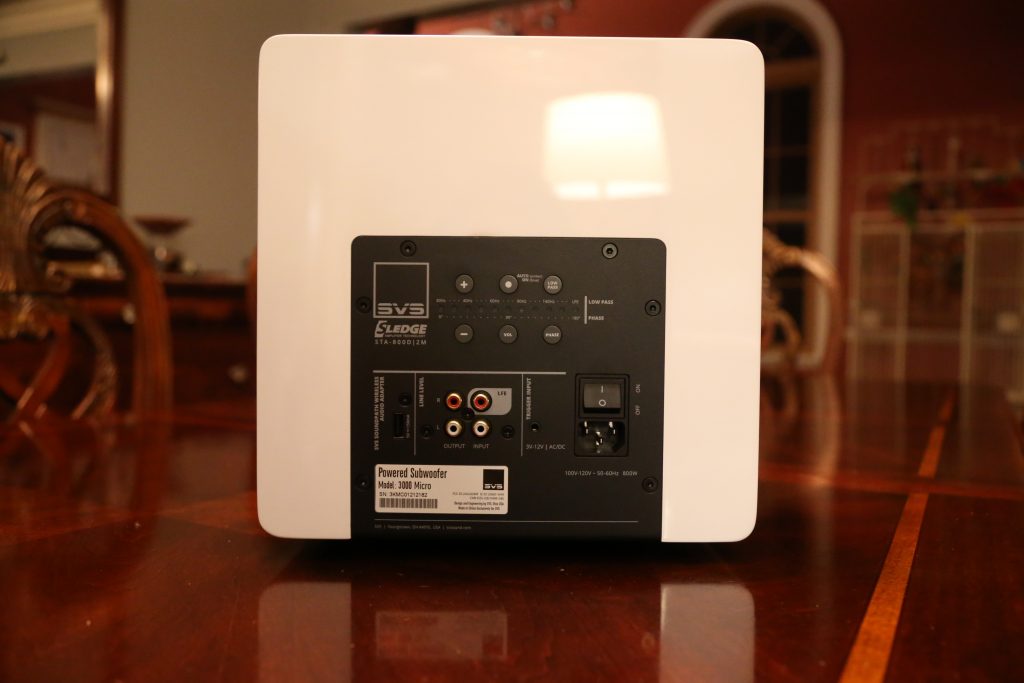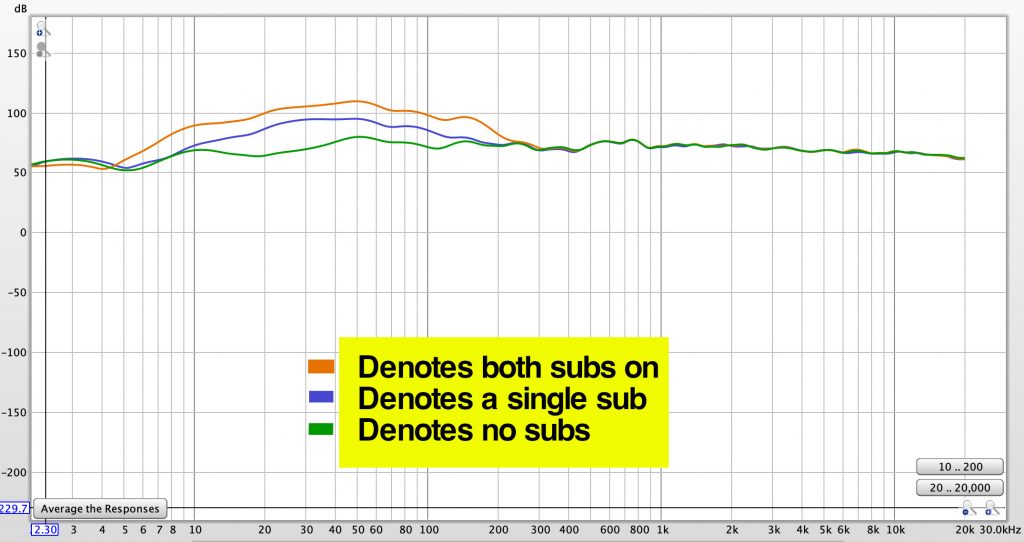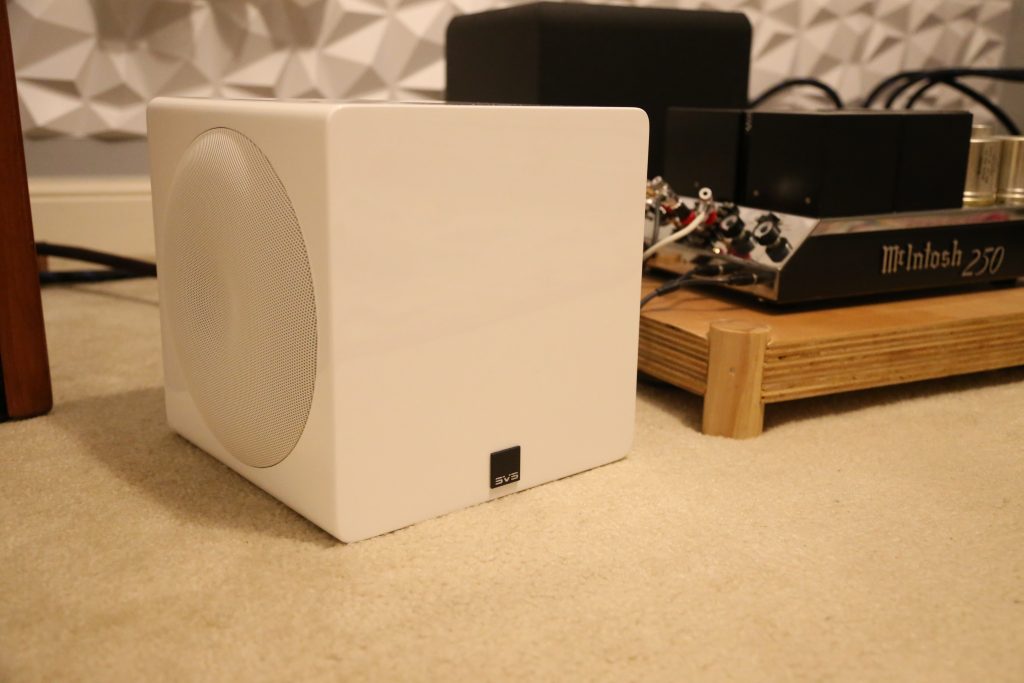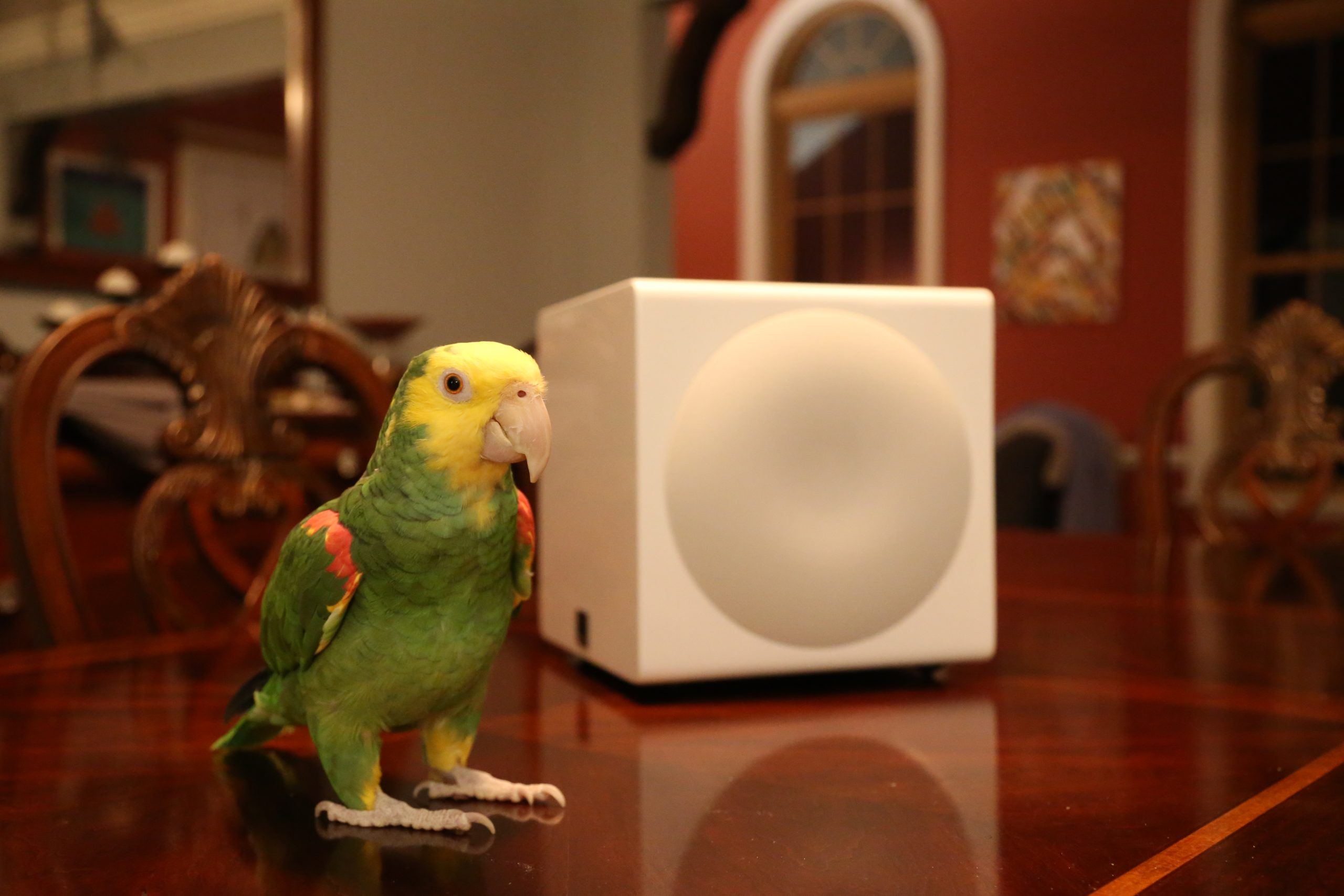SVS is known for their subwoofers, they make some massive earth-shaking subwoofers. Well, they also make a tiny, rather micro subwoofer, but is it earth-shaking? Well, there are certain limitations due to pesky physics and well the more bass you want the larger the speaker has to be to move more air, but that said, you can still have a deep crisp and chest-pounding bass from a small package, assuming it’s done well. SVS has released the 3000 Micro, this subwoofer is actually made up of 2 8 inch drivers, an 800 watt RMS amp all in a package less than a cubic foot. So how does it perform? Is it enough sub to command a price of 900.00 U.S. Dollars? We took a deep dive to find out.
Set Up and tuning
Speaker and Subwoofer setup is crucial to your listening experience. And when it comes to set up what we mean is placement and available adjustments. I got 2 of the 3000 Micro’s to see how they do in a dual sub setup. Dual subs can complicate setup but at the same time alleviate some issues that we will get into later. I moved the subs around the room and listened for an hour or so then repositioned and so on until I found the best sounding practical placement in my room. Something to keep in mind with speakers and subs the best sounding placement may not actually be practical, this is more affected depending on if your space is dedicated to audio or a shared space. Sub placement can be tricky as lower frequency waves are so long that you can get standing waves, nulls, and so on a lot easier than with higher frequencies. Low frequencies also require a thicker material to absorb waves. For my room with the two subs moving them in front and closer together than my speakers and at a slight toe-in seemed to work the best. I was able to get a fairly flat response at the listening position with a slight bump in the low-end which is what I was after for my tastes.
After I got the subs positioned I connected them to the SVS app to play with the multitude of settings available to fine-tune everything. This is what dialed in my frequency curve to basically melt the bass into the music coming from my speakers. This is not something I can do with my Klipsch Sub that I basically have as good as I can with placement and adjustment in the preamp. The SVS app is a nice add-on to their subs. It makes tuning easy and doable from the listening position instead of only from the back of the sub. I set the DB to -15 for each and adjusted the phase, EQ played with the Lowpass Filter to see what worked best for my room. Navigating the app is easy and it is well polished, it doesn’t seem like a cheap afterthought like I have seen with other free accompanying apps in the past.
Dual subs can add to the set up time but the benefit, when done, is well worth it. If you have an odd-shaped room that gets nulls you can place your second sup to give coverage where your first sub can not. Even in a more regular room, the second sub is nice to add to the stereo image of your system. It won’t sound like all the lower registers live over in the corner or wherever you may have your sub. When you have the pair setup and blended into your system it works to enhance the sound stage. SVS also makes using dual subs easier than some others. There are Line Level inputs, as well as outputs. If your preamp/receiver only has one sub out you can daisy chain two subs together. Also on the back, you will see a USB port, this is to power the wireless adapter from SVS so you don’t need to worry about another power source. With the Wireless adapters (not tested in this review) you can really place the subs wherever you want in your room without regard to cabling other than the power cord.

Sound Quality
Subwoofers can oftentimes be boomy or chuffy and lack depth or lack detail. Often this is the case with less expensive woofers and poorly designed cabinets. Muddy bass ruins the experience and bass for the sake of bass is much worse than no bass at all. I have experienced all manner of subwoofers from my teenage years in car audio up to now. Something I have always strived for was clear deep bass. I chased quality while some other folks I grew up with went after quantity. Nothing has changed for me over the years, and the 3000 Micro delivers what I am after. The small sub delivers crystal clear deep bass without the booming or chuffy. You also do not get that sort of speaker noise that sum subs have where you are hearing the speaker itself not the bass it is producing. I have a Boston Acoustics subwoofer in the home theater, and if you turn up the amp too much you get that sort of thin distortion from it. The amp in the 3000 Micro is perfectly paired, even with the volume of the sub turned up to the max I do not hear any audible distortion at my listening level. To get distortion out of them that I can hear I have to have my system up at an uncomfortable volume that I would not use normally.
The 3000 Micro’s are able to be blended seamlessly into your system with their near-infinite tuning availability. This is crucial for a cohesive sound through the full frequency range. As you can see in the Frequency response graphs I have a smooth bump in the low end, there isn’t a major dip in mid-bass or steep roll-off. What that creates in terms of sound is a seemingly single speaker for left or right. It won’t sound like a speaker plus a sub, which is something I have experienced at times with different setups I have had where it seems like a piece of the frequency range is just missing. This is achieved by finding where your speakers roll-off, and blending the sub’s crossover and volume in at that point to create either an extension of a flat response into the lower frequencies or if you are like me a bit of bump.
Frequency reach for the 3000 Micro in my room is going all the way down to 5HZ, but really shining in the 20 to 100HZ range. Most all subs will start to roll off around 20HZ, the key difference is how steep is that roll-off. The Micro’s have a fairly smooth taper down to 5HZ. Frequency response not being flat is not nearly as important to me as a smooth variation. It is nearly impossible to get a perfectly flat response in any real listening scenario. Our rooms play such a big part in that, that for me I chase a smooth line more than a perfectly flat one. My room is far from perfect, but as time goes on and I experiment with more or different treatments we can approach that perfection.

Overall the sound from the 3000 Micro is controlled, precise and deep. There is nothing muddy or boomy about the sub, which is helped by being a sealed box. While sealed usually means less output, in a small to medium-sized room they should provide you with plenty of DB in the lower end. I also tried these in my Home Theater room which is significantly larger than my music room and also a goofy shape to see how they perform there. I’ll cover that more below.
Testing Music
I love to test gear with all different types of music. If something performs well with one type of music but poorly with others it’s really not that great of a product. While there are things that say offer good sound with a multitude of genres but maybe shines a little better with one or a couple of genres I don’t look at that as a bad thing, but rather if the piece only does well with one type of music. That said the 3000 Micro’s handled all the genres I tried extremely well. Listening to Electronic music that has fast deep bass, the light woofers kept up without getting muddy or fatigued sounding. A song I really like to use to test bass clarity is “North End Nightlife” by Headphone Activist. This song pushes subs deep and loud. If a sub is going to have distortion this song will show you. With the subs set at -15DB which is where I preferred them they dealt very well with “North End Nightlife”, though when turned up to the max I heard some distortion and muddiness in the very low parts of the song.
I listen to a decent amount of classical music, and my favorite composer is Tchaikovsky. I listened to Swan Lake on vinyl to see how the Micro 3000 handled the crashing percussion. The result is crisp clean bass that enhances the listening experience. Another exciting classical piece I listened to was Bach’s Cello Suite No.1 in G Major. A slight departure from classical but to blend electronic music with classical instruments is Lindsey Sterling. Her music has deep electronic beats and sounds mixed with Violin that can bridge the gap in genres. Her music tends to be fast and forward, meaning to really enjoy it you will need speakers and subs that can keep up. The small drivers in the Micro 3000 are light enough and rigid enough to move quickly without the sacrifice of physical distortion of the cone.
Another Genre I enjoy a lot is alt-rock, as a child of the 90’s I listen to a lot of late ’90s – early ’00s artists. One of my favorites, while they started in the early 80’s they seemed to really come into their own in the ’90s are the Red Hot Chilli Peppers. One of the first CDs I ever bought with my own money was Californication. Of course, I had to listen to this classic with these subs in the system. Flea’s bass lines are some of the best in rock and roll and hearing them as clear as I could, was a spectacular experience. Around the World has a very aggressive bassline that comes through in spades really making the Red Hot Chilli Peppers sound the way they should. Another band I grew up enjoying that has very aggressive bass is System of a Down, I listened to both Mesmerize and Hypnotize on vinyl and loved what I heard. The dual subs help create that concert-level sound that encompasses you in your listening room. the chest-pounding deep bass brings the physical element of listening to your experience.

Theater Use
In the home theater, the subs perform very well. As sound effects can reach much lower than instruments can the Micro may not be the best option from SVS, that is unless you are constrained by size limitations. I noticed when watching the Dark Knight there were times when there was some audible distortion during explosions and other deep effects. With theater use, I tend to say go as big as you can with your sub, larger drivers and amps handle special sound effects easier than smaller ones tend to. Now that said if you are in a smaller room and require smaller subs simply turning the volume down on the sub will help with clipping and distortion. Overall I was happy with the performance of the two subs watching movies, and wouldn’t hesitate to tell someone to try them out. If I were personally buying new subs for my room I would probably go with the SB3000 as they have the 13″ woofer and would probably play better with my theater room size.
There is one major thing to think about with the 3000 Micro is the woofer placement in the cabinet. There are 2 opposing drivers meaning positioning may be tough as you are going to have to avoid getting too close to side walls as one of your woofers will be against that wall. I have found they like to be closer to the room center than the outsides. Generally, you won’t want subs in corners or close to walls however a single driver sub can be easier to position in a room than one with opposing drivers. Before purchasing any speaker I recommend looking at your room and seeing what others have done with similar rooms or speakers to see what may work best. While that isn’t perfect it can help narrow down options that may work best for you.
Manufacturer Specs
Subwoofer Specs:
- Dimensions (including grilles): 10.9” (278mm) H X 11.7” (297mm) W X 10.7” (271mm) D
- Weight: 22.5lbs (10.2kg)
- Packaged Dimensions: 13.9” (353mm) H X 15.4” (390mm) W X 15.4” (390mm) D
- Packaged Weight: 26.7lbs (12.1kg)
- Dual opposing 8-inch active drivers designed acoustically and electrically in parallel
- 800-watt RMS, 2,500-watt peak Sledge STA-800D amplifier with fully discrete MOSFET output
- Rear-mounted internal amplifier with Intelligent Control Interface (ICI)
- High-end Piano Gloss Black and Piano Gloss White finish options
- Screw-in rubber feet
- Structurally reinforced MDF cabinet construction
Driver Specs:
- Dual opposing 8-inch drivers designed electrically and mechanically in parallel for massive output from and a sonically inert cabinet, and ultra-low system vibration even at maximum output levels
- Precisely tuned overhung motor configuration for precise woofer control at all drive levels
- Proprietary injection-molded NBR surround built for extreme-excursion and longevity at reference playback levels
- Total Excursion (each driver): 24mm Xmax, 37mm Xmech.
- 1100 aluminum single piece cone and junction provide excellent stiffness and a lightweight moving mass with optimized thermal conduction.
- High-current 4-layer copper voice coil winding minimizes distortion and power compression, while providing effective heat dissipation and tuned magnetics for accuracy at high excursion.
- Powerful proprietary ferrite motor system generates high-flux-density magnetic fields to drive room-filling sound pressure levels with pinpoint transient speed.
- Precision machining for motor and narrow tolerance suspension parts maintain control and linearity at full excursion
- 6061 aluminum shorting ring improves linearity of magnetics and reduces distortion and gap inductance
- High-temperature 5025-H18 aluminum former/bobbin
- 5-inch composite poly-cotton extreme-linear-excursion spider
- Dual 24-strand plated copper leads
- High-performance oversized Y30 Ferrite magnet motor
- Top plate assembly with low carbon 1010 steel completes the driver’s precision magnetic circuit
- Oversized low carbon 1010 steel U-yoke for maximum cooling
- Dual 8-inch baskets with FEA optimized powder-coated frames for maximum rigidity, thermal conductivity, and mechanical damping
Amplifier Specs:
- Effortless on-demand power from 800-watt RMS, 2,500-watt peak Sledge STA-800DM amplifier with fully-discrete MOSFET output
- High-efficiency Class-D switching topology with massive 25-amp 600-volt MOSFETs results in ample current, vanishing distortion and excellent linearity to generate massive low-frequency output with pinpoint accuracy
- High-resolution 50MHz Analog Devices Audio DSP with double precision 56-bit filtering industry best processing power for advanced control and pristine output
- User adjustable settings for system performance optimization: low pass filter, phase, polarity, room gain, and three parametric equalizers
- Groundbreaking SVS subwoofer DSP and Bluetooth smartphone control app for iOS, Android and Amazon devices allow custom tuning and user presets for every room and system
- Stereo RCA input and output with ultra-wide input voltage for consumer and professional audio applications
- Rear panel Intelligent Control Interface (ICI) user interface with blue-LED light bar display and easy push-button controls
- Auto/On and 3-12V AC/DC trigger for Maximum Installation Convenience
- Input impedance 16 kΩ (unbalanced RCA)
- Environmentally-friendly 0.5-watt low-standby-power consumption
- RoHS compliant, lead-free construction, world-wide safety certifications
SVS App Specs:
- Powerful Bluetooth-controlled subwoofer DSP app works with iOS, Android, and Amazon operating systems
- Provides easy and convenient way to adjust crossover frequencies, parametric EQ, polarity, room gain and all other bass-management functions
- Three convenient custom presets allow for perfect tuning in any room or system, from your favorite seat
- Bidirectional-feedback shows adjustments in real time on both app and subwoofer rear panel interface
Included Accessories:
- Dual protective non-resonant steel mesh grilles
- Isolating elastomer feet
- Heavy-duty, high-current 6-foot power cord
- Quick Start Guide

Conclusion
The 3000 Micro is a great subwoofer, albeit a little expensive for some folks. The thing is in the market of Hifi Subs they are up against the likes of REL, JL, as well as most speaker manufacturers. Most in the industry regard SVS, REL, and JL as the dominators in the subwoofer market, but companies like Paradigm, Klipsch, Martin Logan, and others all make their own subs as well. Interesting enough in many of the forums and groups I am in when someone looks for a sub the recommendations will be about 80-90% REL or SVS and the remaining votes going to their preferred loudspeaker company. I often see the Dynamo get skipped over in Martin Logan groups in favor of REL or SVS. When it comes to small form factor subs REL, SVS, and Kef are the only mainstream options that I am aware of, and I personally have not heard the T series (REL’s small form subs). Though I have heard some of their larger options as well as SVS’s and there is stiff competition and I would imagine this translates to the T series as well. That said a REL T series starts at 699.00 for the T/5 with one 8 inch driver, and 125 watts, moving up to the T/9 will get you a 10-inch driver and 300 watts, however for 1499.00 U.S. I think SVS is offering more value than REL in the small form factor segment at least. The 3000 Micro surprised me with the output, the amount of bass you can get out of such a small subwoofer is impressive. Not only how much bass you get, but how clean and clear it is as well. I would say if you are in the market for a small form factor sub you should audition the 3000 Micro, and if the budget allows maybe a pair of them.
For information on where to buy or how to audition your own click the link below.






Disclaimer: SVS Provided a loaned pair of 3000 Micro’s for the purpose of conducting a review, SVS nor any affiliates paid in full or part in exchange for a review.

